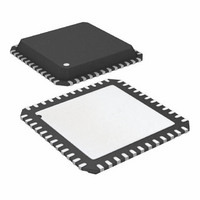ADF7025BCPZ Analog Devices Inc, ADF7025BCPZ Datasheet - Page 16

ADF7025BCPZ
Manufacturer Part Number
ADF7025BCPZ
Description
IC ASK/FSK TXRX 928MHZ 48-LFCSP
Manufacturer
Analog Devices Inc
Datasheet
1.ADF7025BCPZ.pdf
(44 pages)
Specifications of ADF7025BCPZ
Frequency
431MHz ~ 464MHz, 862MHz ~ 870MHz and 902MHz ~ 928MHz
Data Rate - Maximum
384kbps
Modulation Or Protocol
FSK
Applications
Keyless Entery, Home Automation, Wireless Audio/Video
Power - Output
-20dBm ~ 13dBm
Sensitivity
-104dBm
Voltage - Supply
2.3 V ~ 3.6 V
Current - Receiving
19mA
Current - Transmitting
28mA
Data Interface
PCB, Surface Mount
Antenna Connector
PCB, Surface Mount
Operating Temperature
-40°C ~ 85°C
Package / Case
48-LFCSP
Receiving Current
21mA
Transmitting Current
19.3mA
Data Rate
384Kbps
Frequency Range
431MHz To 928MHz
Modulation Type
FSK
Rf Ic Case Style
LFCSP
No. Of Pins
48
Lead Free Status / RoHS Status
Lead free / RoHS Compliant
For Use With
EVAL-ADF70XXEKZ1 - KIT DEV ADF702X FOR BF533EZKITEVAL-ADF7025DBZ1 - BOARD EVAL ADF7025 902-928MHZ
Memory Size
-
Lead Free Status / RoHS Status
Lead free / RoHS Compliant, Lead free / RoHS Compliant
Available stocks
Company
Part Number
Manufacturer
Quantity
Price
Part Number:
ADF7025BCPZ-RL
Manufacturer:
ADI/亚德诺
Quantity:
20 000
ADF7025
Analog Lock Detect
This N-channel open-drain lock detect should be operated with
an external pull-up resistor of 10 kΩ nominal. When a lock has
been detected, this output is high with narrow low-going pulses.
Voltage Regulators
The ADF7025 contains four regulators to supply stable voltages
to the part. The nominal regulator voltage is 2.3 V. Each regulator
should have a 100 nF capacitor connected between VREG and
GND. When CE is high, the regulators and other associated
circuitry are powered on, drawing a total supply current of 2 mA.
Bringing the chip-enable pin low disables the regulators,
reduces the supply current to less than 1 µA, and erases all
values held in the registers. The serial interface operates from
a regulator supply; therefore, to write to the part, the user must
have CE high and the regulator voltage must be stabilized.
Regulator status (VREG4) can be monitored using the regulator
ready signal from MUXOUT.
Loop Filter
The loop filter integrates the current pulses from the charge
pump to form a voltage that tunes the output of the VCO to the
desired frequency. It also attenuates spurious levels generated by
the PLL. A typical loop filter design is shown in Figure 22.
In general, a loop filter bandwidth (LBW) of between the data
rate and twice the data rate is recommended. Widening the
LBW excessively reduces the time spent jumping between
frequencies, but it can cause insufficient spurious attenuation.
Narrow-loop bandwidths can result in the loop taking long
periods of time to attain lock. For the ADF7025 in receive mode,
the loop filter bandwidth affects the close-in blocking perform-
ance. The narrower the bandwidth of the loop filter, the greater
the close-in interference resilience of the receiver.
Careful design of the loop filter is critical to obtaining accurate
FSK modulation. The free design tool ADIsimPLL can be used
to design loop filters for the ADF7025.
N Counter
The feedback divider in the ADF7025 PLL consists of an 8-bit
integer counter and a 14-bit Σ-∆ Fractional-N divider. The
integer counter is the standard pulse-swallow type common in
PLLs. This sets the minimum integer divide value to 31.
PUMP OUT
CHARGE
Figure 22. Typical Loop Filter Configuration
VCO
Rev. A | Page 16 of 44
The fractional divide value gives very fine resolution at the
output, where the output frequency of the PLL is calculated as
The combination of the Integer-N (maximum = 255) and the
Fractional-N (maximum = 16383/16384) gives a maximum N
divider of 255 + 1. Therefore, the minimum usable PFD is
PDF
For example, when operating in the European 868 MHz to
870 MHz band, PFD
Voltage Controlled Oscillator
To minimize spurious emissions, the on-chip VCO operates
from 1732 MHz to 1856 MHz. The VCO signal is then divided
by 2 to give the required frequency for the transmitter and the
required LO frequency for the receiver.
The VCO should be re-centered, depending on the required
frequency of operation, by programming the VCO adjust bits
R1_DB [20:21].
For operation in the 862 MHz to 870 MHz band, it is recom-
mended to use a VCO bias of at least Setting 10 and to set the
VCO adjust bit to Setting 0. For operation in the 902 MHz to
928 MHz band, it is recommended to use a VCO bias of at least
Setting 12 and to set the VCO adjust bit to Setting 3. This is to
ensure correct operation under all conditions.
The VCO is enabled as part of the PLL by the PLL-enable bit,
R0_DB28.
An additional frequency divide-by-2 is included to allow
operation in the lower 431 MHz to 464 MHz bands. To enable
operation in these bands, R1_DB13 should be set to 1. The
VCO needs an external 22 nF between the VCO and the
regulator to reduce internal noise.
MIN
F
REFERENCE IN
OUT
[Hz] = Maximum Required Output Frequency/(255 + 1)
4R
=
XTAL
R
CHARGE
FRACTIONAL-N
PUMP
PFD/
×
MIN
Figure 23. Fractional-N PLL
(
Integer
equals 3.4 MHz.
Σ-∆ MODULATOR
THIRD-ORDER
N
+
Fractional
2
15
INTEGER-N
VCO
4N
N
)













